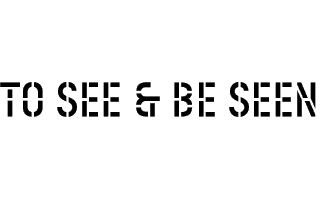|
| |
 |
|

|

Cat. #278 (1972), TO SEE AND BE SEEN, 1972. Language and the materials referred to, dimensions variable. Solomon R. Guggenheim Museum, New York, Panza Collection, Gift. 92.4193
|

Lawrence Weiner is a sculptor whose medium is language. His texts describe material processes and physical conditions. Since 1968, when he concluded that the actual construction of a work was not critical to its existence in the world, Weiner has authored hundreds of linguistic works. Prior to this time his material sculptures had been prefaced by titles that dictated the means of their fabrication. When the outdoor installation A SERIES OF STAKES SET IN THE GROUND AT REGULAR INTERVALS TO FORM A RECTANGLE — TWINE STRUNG FROM STAKE TO STAKE TO DEMARK A GRID — A RECTANGLE REMOVED FROM THIS RECTANGLE was damaged, Weiner realized that the essence of a work is textual and not physical. This led him to the following formulation, first published in 1968, which continues to outline his conceptual approach to artmaking: "(1) The artist may construct the piece. (2) The piece may be fabricated. (3) The piece need not be built. (4) Each being equal and consistent with the intent of the artist, the decision as to condition rests with the receiver upon the occasion of receivership."
With these instructions, Weiner shifted the responsibility of the work's realization to its audience, who can imagine for themselves the materials or actions referred to. Ultimately, the distillation of his medium to language expanded the formal and conceptual possibilities of each work, which change with every viewer and their respective contexts. TO SEE AND BE SEEN, one of many works Weiner based on ready-made language structures, evokes the social attitude expressed by the idiom, its meaning magnified by the public setting of the museum.
While Weiner's art may be discussed in relation to Minimalism and Post-Minimalism because of its emphasis on simple materials and actions, his approach complicates these movements' interest in the viewer's phenomenological relationship to a work of art by subverting any physical or visual encounter with an actual object.
|
|